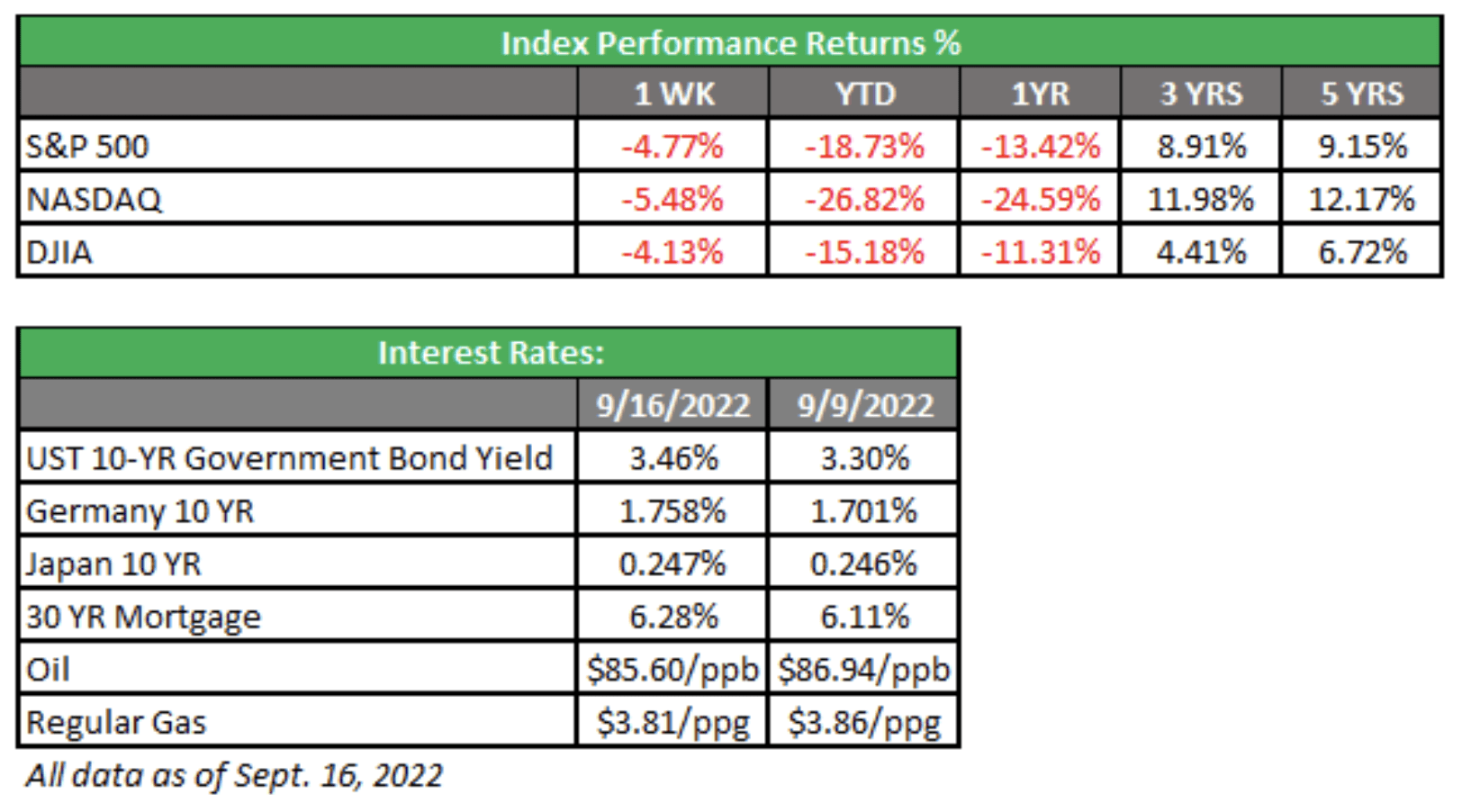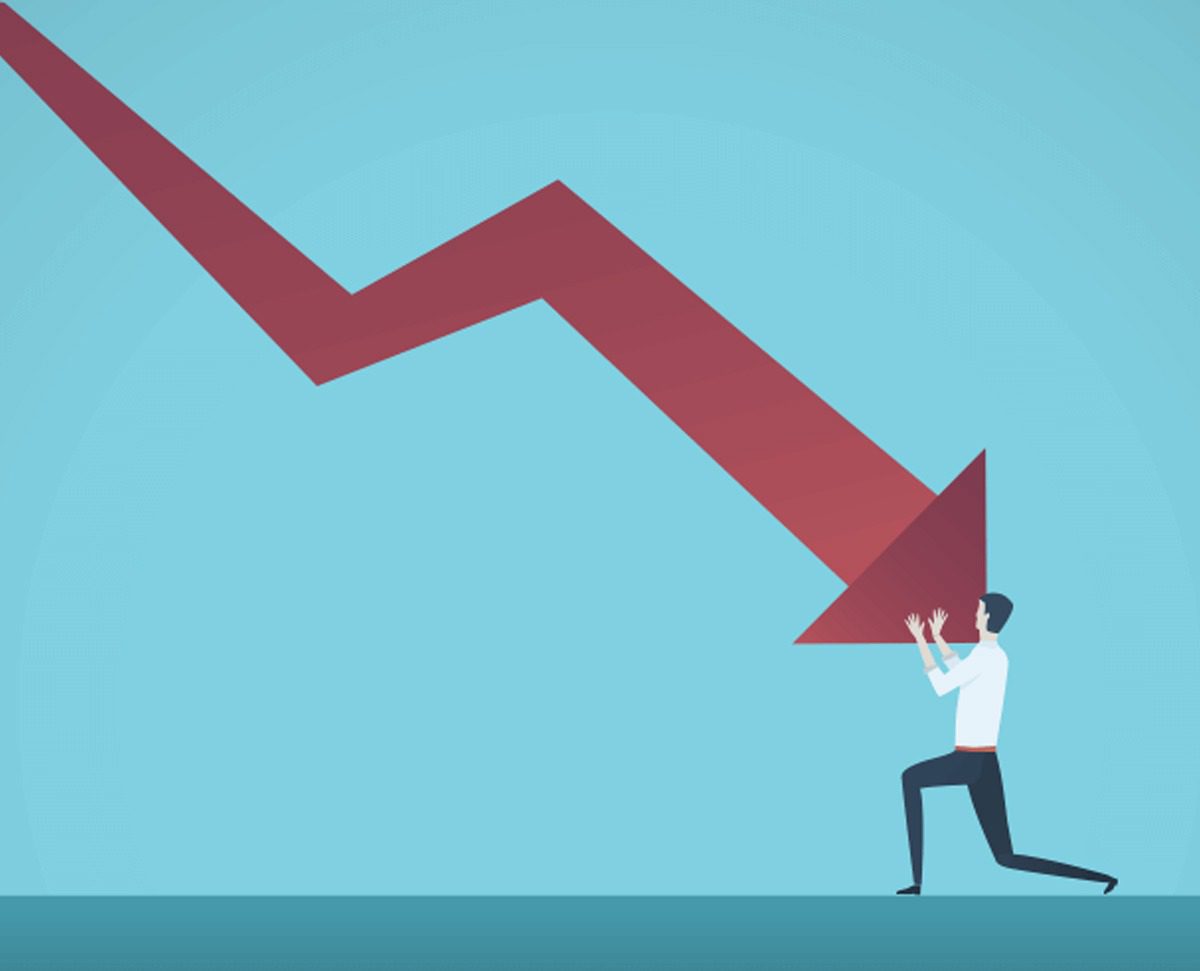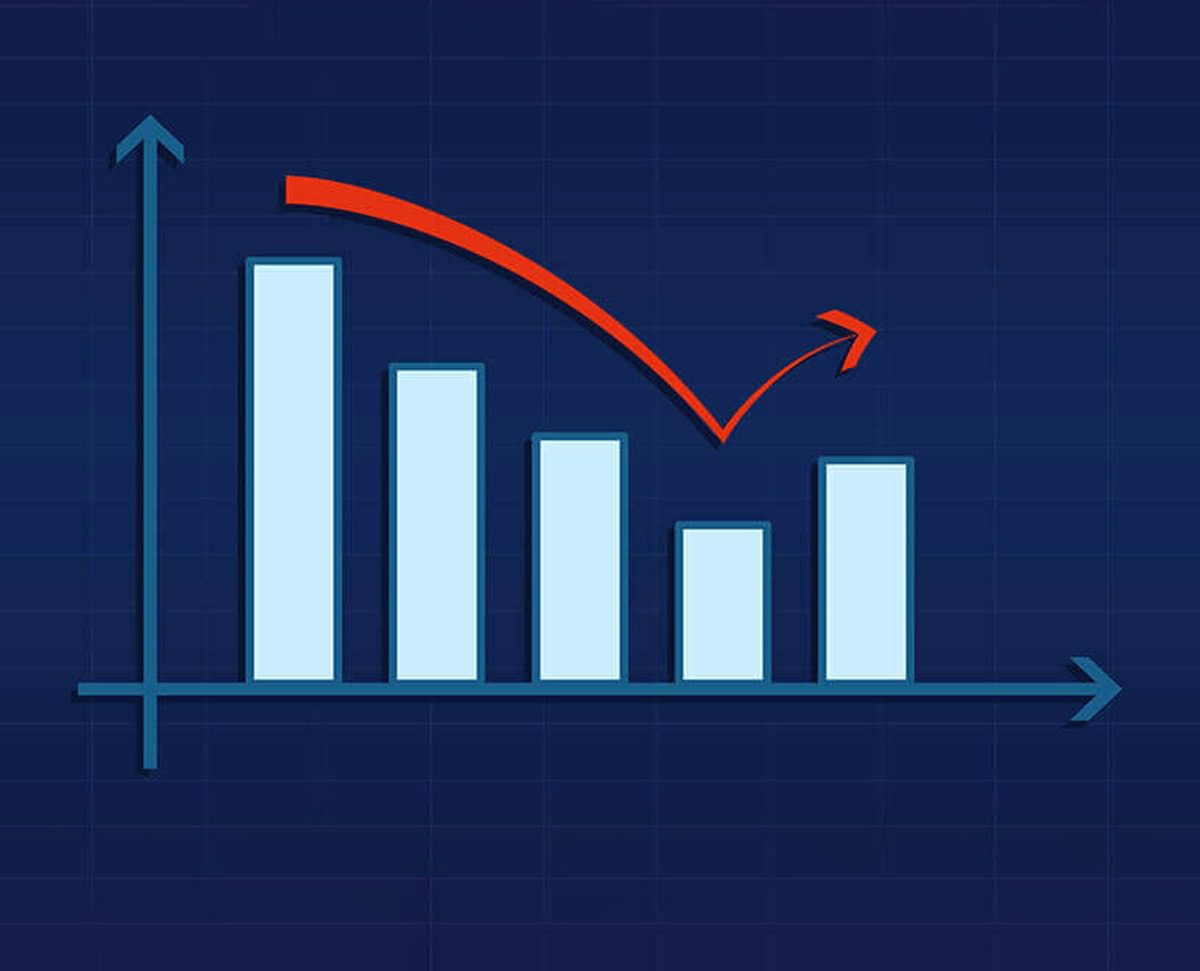
The Week In Review: Sept. 4 – 10
September 13, 2022
The Week In Review: Sept. 18 – 24
September 27, 2022
Markets finish positive and Fed stays the course
Inflation fears intensify, drive markets down
Domestic stocks fell sharply last week, as inflation fears intensified and short-term bond yields reached levels last seen in 2007. The S&P 500 recorded its largest weekly drop since mid-June, while the Dow tumbled 1,200 points on Thursday for its worst drop in two months.
The defining event of the week was the consumer price index (CPI) report. The CPI numbers for August came in above expectations and dimmed hopes the economy had moved beyond “peak inflation.” Prices rose 8.3% for the 12 months ended in August, down just slightly from July’s 8.5%. Another concerning number was core inflation, which jumped to 6.3% — its highest level since March.
The producer price index (PPI) also came in hot. August PPI decreased 0.1% last month, but still remained elevated at 8.7% on an unadjusted basis. And while gasoline prices may be falling, other energy costs are rising. Electricity costs rose 15.8% in August from year ago, driven by higher prices for natural gas.
Last week also brought news of impending layoffs at several large companies, including Goldman Sachs, Ford and Microsoft. But weekly jobless claims offered a different picture, falling to their lowest level since early summer at 213,000.
Other closely watched data reported last week included retail sales. Falling gas prices helped the preliminary reading on consumer sentiment for September, produced by the University of Michigan, which hit a 5-month high. Plus five-year inflation expectations in the survey fell to 2.8%, the lowest in over a year.
After taking a nosedive following the CPI report on Tuesday, markets rebounded slightly before falling again late in the week. The catalyst for the drop this time: a gloomy outlook from FedEx, which announced it was pulling its earnings guidance for fiscal year 2023 due to expectations for a “continued volatile operating environment.” The new FedEx CEO fueled the fire by telling a CNBC interviewer he expected a global recession. Following the comments, FedEx stock fell by about 21% on Friday.
U.S. Treasury yields pushed higher over the course of the week, especially on short- and intermediate-term maturities, as disappointing inflation data and a further decline in jobless claims pretty much cemented another 75-basis-point hike by the Fed at their meeting this week. Expectations for continued rapid monetary tightening pushed the two-year Treasury note yield to its highest level in nearly 15 years.
So what does this all mean as we head toward the end of the third quarter and into the fourth? Investors should be prepared for ongoing volatility over the next several months, as short-term events continue to rattle markets. The best thing you can do right now is to schedule an appointment with your financial advisor to review your financial plan and make sure it still works for your goals. Above all, stay focused on the long term in your investment outlook.
Domestic stocks fell sharply last week, as inflation fears intensified and short-term bond yields reached levels last seen in 2007. The S&P 500 recorded its largest weekly drop since mid-June, while the Dow tumbled 1,200 points on Thursday for its worst drop in two months.
The defining event of the week was the consumer price index (CPI) report. The CPI numbers for August came in above expectations and dimmed hopes the economy had moved beyond “peak inflation.” Prices rose 8.3% for the 12 months ended in August, down just slightly from July’s 8.5%. Another concerning number was core inflation, which jumped to 6.3% — its highest level since March.
The producer price index (PPI) also came in hot. August PPI decreased 0.1% last month, but still remained elevated at 8.7% on an unadjusted basis. And while gasoline prices may be falling, other energy costs are rising. Electricity costs rose 15.8% in August from year ago, driven by higher prices for natural gas.
Last week also brought news of impending layoffs at several large companies, including Goldman Sachs, Ford and Microsoft. But weekly jobless claims offered a different picture, falling to their lowest level since early summer at 213,000.
Other closely watched data reported last week included retail sales. Falling gas prices helped the preliminary reading on consumer sentiment for September, produced by the University of Michigan, which hit a 5-month high. Plus five-year inflation expectations in the survey fell to 2.8%, the lowest in over a year.
After taking a nosedive following the CPI report on Tuesday, markets rebounded slightly before falling again late in the week. The catalyst for the drop this time: a gloomy outlook from FedEx, which announced it was pulling its earnings guidance for fiscal year 2023 due to expectations for a “continued volatile operating environment.” The new FedEx CEO fueled the fire by telling a CNBC interviewer he expected a global recession. Following the comments, FedEx stock fell by about 21% on Friday.
U.S. Treasury yields pushed higher over the course of the week, especially on short- and intermediate-term maturities, as disappointing inflation data and a further decline in jobless claims pretty much cemented another 75-basis-point hike by the Fed at their meeting this week. Expectations for continued rapid monetary tightening pushed the two-year Treasury note yield to its highest level in nearly 15 years.
So what does this all mean as we head toward the end of the third quarter and into the fourth? Investors should be prepared for ongoing volatility over the next several months, as short-term events continue to rattle markets. The best thing you can do right now is to schedule an appointment with your financial advisor to review your financial plan and make sure it still works for your goals. Above all, stay focused on the long term in your investment outlook.
Coming This Week
- The Fed will meet on Tuesday and Wednesday. It’s expected to raise rates by another 75 basis points (0.75%), taking the Fed funds rates to 3.0% to 3.25%.
- We’ll see a variety of housing data this week, including building permits, housing starts and existing home sales. Mortgage rates topped 6% this week, hitting levels not seen since 2008.
- Otherwise, it will be a light week for data. That’s not necessarily a bad thing — the Fed’s actions will give markets enough to chew on this week.

AE Wealth Management, LLC (“AEWM”) is an SEC Registered Investment Adviser (RIA) located in Topeka, Kansas. Registration does not denote any level of skill or qualification. The advisory firm providing you this report is an independent financial services firm and is not an affiliate company of AE Wealth Management, LLC. AEWM works with a variety of independent advisors. Some of the advisors are Investment Adviser Representatives (IAR) who provide investment advisory services through AEWM. Some of the advisors are Registered Investment Advisers providing investment advisory services that incorporate some of the products available through AEWM.
Information regarding the RIA offering the investment advisory services can be found on https://brokercheck.finra.org/.
Investing involves risk, including the potential loss of principal. No investment strategy can guarantee a profit or protect against loss in periods of declining values.
The information and opinions contained herein, provided by third parties, have been obtained from sources believed to be reliable, but accuracy and completeness cannot be guaranteed by AE Wealth Management.
This information is not intended to be used as the sole basis for financial decisions, nor should it be construed as advice designed to meet the particular needs of an individual’s situation. None of the information contained herein shall constitute an offer to sell or solicit any offer to buy a security or insurance product.
9/22 – 2410942-3








Weekly Market Commentary 4/5/2024
Read more